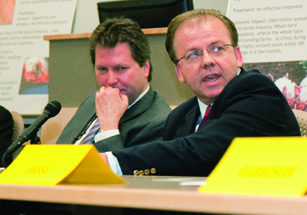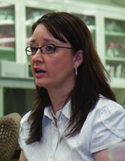Planning ahead
K-Staters working to minimize the impact of H1N1 (swine) flu on campus
Since the news about the H1N1 (swine) flu virus hit the airwaves, officials at K-State have been keeping a close eye on the situation and are working to ensure there are programs in place to minimize the consequences of a potential outbreak.
 Representatives from every corner of campus are meeting each morning to go over the present situation and discuss K-State's Pandemic Influenza Plan and any concerns they're hearing on campus.
Representatives from every corner of campus are meeting each morning to go over the present situation and discuss K-State's Pandemic Influenza Plan and any concerns they're hearing on campus.
K-State's Pandemic Influenza Plan lays out the steps that could be taken by university officials should the Centers for Disease Control and Prevention and the World Health Organization declare that there is a pandemic of influenza. K-State's plan can be viewed at http://www.k-state.edu/safety/Documents/pandemic_flu_plan09.pdf
"The plan was developed because of the possibility of a flu pandemic similar to the 1918 pandemic," said Steven Galitzer, director of environmental health and safety at K-State. "We developed a plan of action to aid in administrative decision making and to help university departments plan for the worst."
The phrase "pandemic flu" is used to refer to an epidemic of the influenza virus that spreads internationally and infects a large proportion of the world's human population.
 The campus' greatest risk is considered to be a highly transmissible virus with more than 3,000 students in residence halls living in close proximity and sharing facilities.
The campus' greatest risk is considered to be a highly transmissible virus with more than 3,000 students in residence halls living in close proximity and sharing facilities.
The purpose of the university's plan is to minimize the risk of pandemic flu to students, faculty and staff; support students who remain in Manhattan; continue functions essential to university operations during a pandemic; and to resume normal teaching, research and service operations as soon as possible after the event.
When, exactly, the plan goes into effect depends on whether there are confirmed cases in Manhattan, or on campus, and what phase the World Health Organization has assigned the outbreak.
As of Monday, May 4, no cases had been discovered at K-State and the World Health Organization had declared the outbreak a Phase 5 incident. Phase 5 is characterized by human-to-human spread of the virus into at least two countries in one World Health Organization region. "The declaration of Phase 5 is a strong signal that a  pandemic is imminent and that the time to finalize the organization, communication and implementation of the planned mitigation measures is short," according to the organization's Web site.
pandemic is imminent and that the time to finalize the organization, communication and implementation of the planned mitigation measures is short," according to the organization's Web site.
In addition to the plan, K-State has created a Web site dedicated to information about the H1N1 (swine) flu virus, as well as detailed information about what an outbreak could mean to campus. That site is: http://www.k-state.edu/lafene/swineflu/ This Web site will be kept up to date with the latest information.
To assist students, their parents and others a hotline has also been launched: 532-7233, or 532-SAFE. This line will provide general information and allow people to connect to Lafene Student Health Center or the office of student life.
Photos: (Top) Bob Rowland, professor of diagnostic medicine and pathobiology, addresses media during a K-State news conference at the Biosecurity Research Institute. (Middle) Environmental Health Officer and State Public Health Veterinarian Ingrid C. Garrison talks about the state health picture with regard to H1N1 (swine) flu. (Bottom) Dr. Robert Tackett, medical director of Lafene Student Health Center, talks about student health matters.